Zain Ali
Robust Design of Beyond-Diagonal Reconfigurable Intelligent Surface Empowered RSMA-SWIPT System Under Channel Estimation Errors
Aug 11, 2025Abstract:This work explores the integration of rate-splitting multiple access (RSMA), simultaneous wireless information and power transfer (SWIPT), and beyond-diagonal reconfigurable intelligent surface (BD-RIS) to enhance the spectral-efficiency, energy-efficiency, coverage, and connectivity of future sixth-generation (6G) communication networks. Specifically, with a multiuser BD-RIS-empowered RSMA-SWIPT system, we jointly optimize the transmit precoding vectors, the common rate proportion of users, the power-splitting ratios, and scattering matrix of BD-RIS node, under the assumption of imperfect channel state information (CSI). Additionally, to better capture practical hardware behavior, we incorporate a nonlinear energy harvesting model under energy harvesting constraints. We design a robust optimization framework to maximize the system sum-rate, while explicitly accounting for the worst-case impact of CSI uncertainties. Further, we introduce an alternating optimization framework that partitions the problem into several blocks, which are optimized iteratively. More specifically, the transmit precoding vectors are optimized by reformulating the problem as a convex semidefinite programming through successive-convex approximation (SCA), whereas the power-splitting problem is solved using the MOSEK-enabled CVX toolbox. Subsequently, to optimize the scattering matrix of the BD-RIS, we first employ SCA to reformulate the problem into a convex form, and then design a manifold optimization strategy based on the Conjugate-Gradient method. Finally, numerical simulation results reveal that the proposed scheme provides significant performance improvements over existing benchmarks and demonstrates rapid convergence within a reasonable number of iterations.
CR-Enabled NOMA Integrated Non-Terrestrial IoT Networks with Transmissive RIS
Aug 27, 2024



Abstract:This work proposes a T-RIS-equipped LEO satellite communication in cognitive radio-enabled integrated NTNs. In the proposed system, a GEO satellite operates as a primary network, and a T-RIS-equipped LEO satellite operates as a secondary IoT network. The objective is to maximize the sum rate of T-RIS-equipped LEO satellite communication using downlink NOMA while ensuring the service quality of GEO cellular users. Our framework simultaneously optimizes the total transmit power of LEO, NOMA power allocation for LEO IoT (LIoT) and T-RIS phase shift design subject to the service quality of LIoT and interference temperature to the primary GEO network. To solve the non-convex sum rate maximization problem, we first adopt successive convex approximations to reduce the complexity of the formulated optimization. Then, we divide the problem into two parts, i.e., power allocation of LEO and phase shift design of T-RIS. The power allocation problem is solved using KKT conditions, while the phase shift problem is handled by Taylor approximation and semidefinite programming. Numerical results are provided to validate the proposed optimization framework.
Deep Reinforcement Learning for Backscatter Communications: Augmenting Intelligence in Future Internet of Things
Sep 21, 2023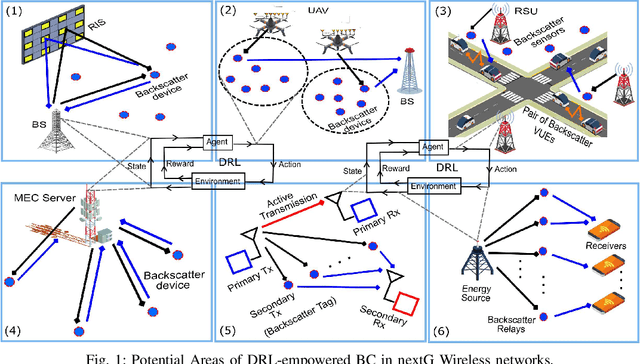
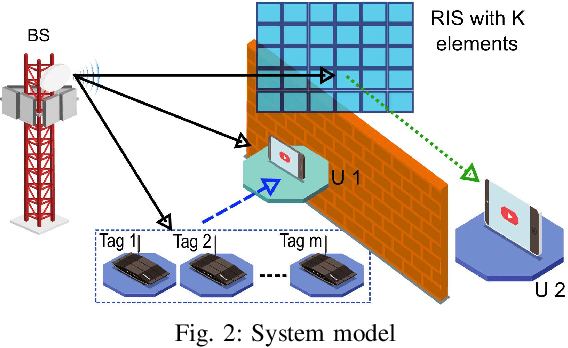


Abstract:Backscatter communication (BC) technology offers sustainable solutions for next-generation Internet-of-Things (IoT) networks, where devices can transmit data by reflecting and adjusting incident radio frequency signals. In parallel to BC, deep reinforcement learning (DRL) has recently emerged as a promising tool to augment intelligence and optimize low-powered IoT devices. This article commences by elucidating the foundational principles underpinning BC systems, subsequently delving into the diverse array of DRL techniques and their respective practical implementations. Subsequently, it investigates potential domains and presents recent advancements in the realm of DRL-BC systems. A use case of RIS-aided non-orthogonal multiple access BC systems leveraging DRL is meticulously examined to highlight its potential. Lastly, this study identifies and investigates salient challenges and proffers prospective avenues for future research endeavors.
Reconfigurable Intelligent Surfaces Enhanced NOMA D2D Communications Underlaying UAV Networks
Aug 01, 2023Abstract:Device-to-device (D2D) communications offers high spectral efficiency, low energy consumption and transmission latency. However, one of the main limitations of D2D communications is co-channel interference from underlaying wireless system. Reconfigurable intelligent surfaces (RIS) is a promising technology because it can manipulate the electromagnetic waves in their environment to overcome interference and enhance wireless communications. This paper considers RIS enhanced D2D communications underlaying unmanned aerial vehicle (UAV) networks with non-orthogonal multiple access (NOMA). The objective is to maximize the sum rate of NOMA D2D communications by simultaneously optimizing the power budget of D2D transmitter, NOMA power allocation coefficients of D2D receivers and passive beamforming of RIS while guaranteeing the quality of services of UAV user. Due to non-convexity, the optimization problem is intractable and challenging to handle. Therefore, it is solved in two parts using alternating optimization. Simulation results unviel the performance of the proposed RIS enhanced D2D communications scheme. Results demonstrate that the proposed scheme achieves 15\% and 27\% higher sum rates compared to the fixed power D2D and orthogonal D2D schemes.
Rate Splitting Multiple Access for Next Generation Cognitive Radio Enabled LEO Satellite Networks
Aug 07, 2022



Abstract:This paper proposes a cognitive radio enabled LEO SatCom using RSMA radio access technique with the coexistence of GEO SatCom network. In particular, this work aims to maximize the sum rate of LEO SatCom by simultaneously optimizing the power budget over different beams, RSMA power allocation for users over each beam, and subcarrier user assignment while restricting the interference temperature to GEO SatCom. The problem of sum rate maximization is formulated as non-convex, where the global optimal solution is challenging to obtain. Thus, an efficient solution can be obtained in three steps: first we employ a successive convex approximation technique to reduce the complexity and make the problem more tractable. Second, for any given resource block user assignment, we adopt KKT conditions to calculate the transmit power over different beams and RSMA power allocation of users over each beam. Third, using the allocated power, we design an efficient algorithm based on the greedy approach for resource block user assignment. Numerical results demonstrate the benefits of the proposed optimization scheme compared to the benchmark schemes.
Rate Splitting Multiple Access for Cognitive Radio GEO-LEO Co-Existing Satellite Networks
Aug 04, 2022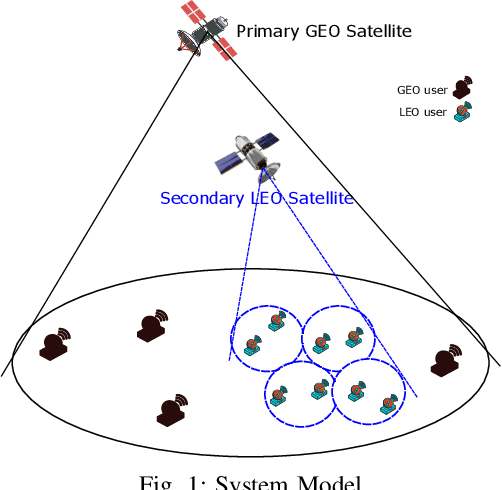
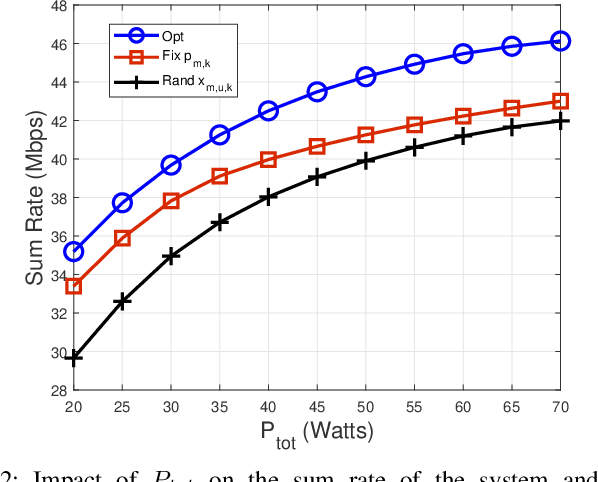
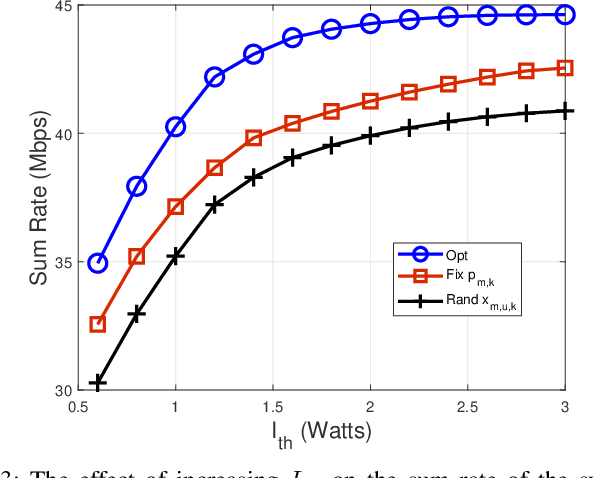
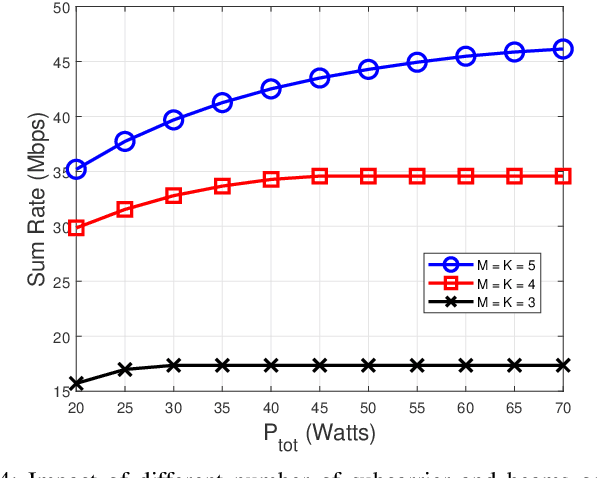
Abstract:LEO satellite communication has drawn particular attention recently due to its high data rate services and low round-trip latency. It is low-cost to launch and can provide global coverage. However, the spectrum scarcity might be one of the critical challenges in the growth of LEO satellites, impacting severe restrictions on the development of ground-space integrated networks. To address this issue, we propose RSMA for CR enabled GEO-LEO coexisting satellite network. In particular, this work aims to maximize the system's sum rate by simultaneously optimizing the power allocation and subcarrier beam assignment of LEO satellite communication while restricting the interference temperature to GEO satellite users. The problem of sum rate maximization is formulated as non-convex and a Global optimal solution is challenging to obtain. Therefore, we first employ the successive convex approximation technique to reduce the complexity and make the problem more tractable. Then for the power allocation, we exploit KKT condition and adopt an efficient algorithm based on the greedy approach for subcarrier beam assignment. We also propose two suboptimal schemes with fixed power allocation and random subcarrier beam assignment as the benchmark. Results demonstrate the benefits of the proposed scheme compared to the benchmark schemes.
Cooperative Backscatter NOMA with Imperfect SIC: Towards Energy Efficient Sum Rate Maximization in Sustainable 6G Networks
Jul 07, 2022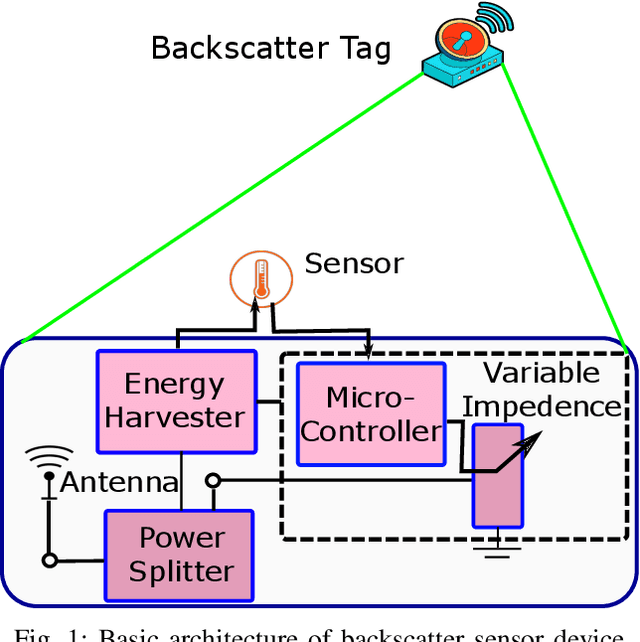
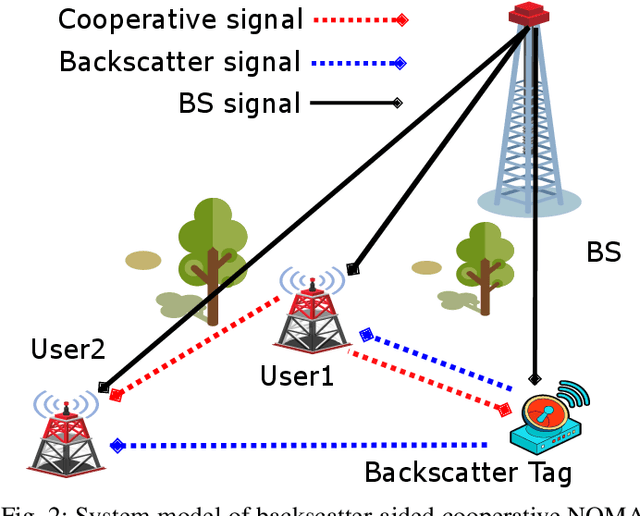
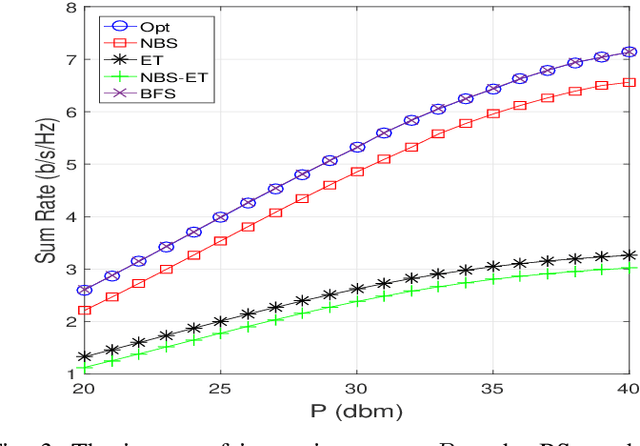
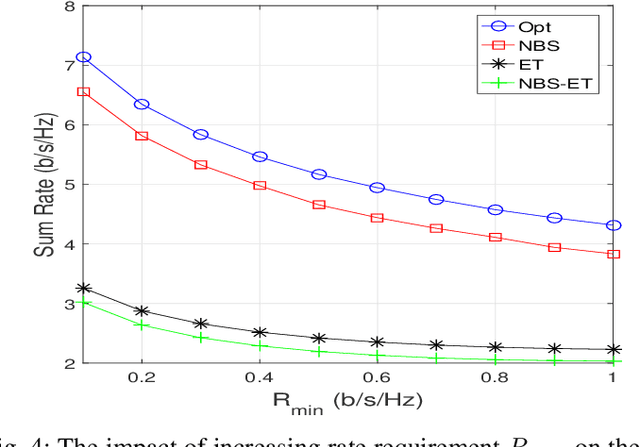
Abstract:The combination of backscatter communication with non-orthogonal multiple access (NOMA) has the potential to support low-powered massive connections in upcoming sixth-generation (6G) wireless networks. More specifically, backscatter communication can harvest and use the existing RF signals in the atmosphere for communication, while NOMA provides communication to multiple wireless devices over the same frequency and time resources. This paper has proposed a new resource management framework for backscatter-aided cooperative NOMA communication in upcoming 6G networks. In particular, the proposed work has simultaneously optimized the base station's transmit power, relaying node, the reflection coefficient of the backscatter tag, and time allocation under imperfect successive interference cancellation to maximize the sum rate of the system. To obtain an efficient solution for the resource management framework, we have proposed a combination of the bisection method and dual theory, where the sub-gradient method is adopted to optimize the Lagrangian multipliers. Numerical results have shown that the proposed solution provides excellent performance. When the performance of the proposed technique is compared to a brute-forcing search technique that guarantees optimal solution however, is very time-consuming, it was seen that the gap in performance is actually 0\%. Hence, the proposed framework has provided performance equal to a cumbersome brute-force search technique while offering much less complexity. The works in the literature on cooperative NOMA considered equal time distribution for cooperation and direct communication. Our results showed that optimizing the time-division can increase the performance by more than 110\% for high transmission powers.
Integration of NOMA with Reflecting Intelligent Surfaces: A Multi-cell Optimization with SIC Decoding Errors
May 06, 2022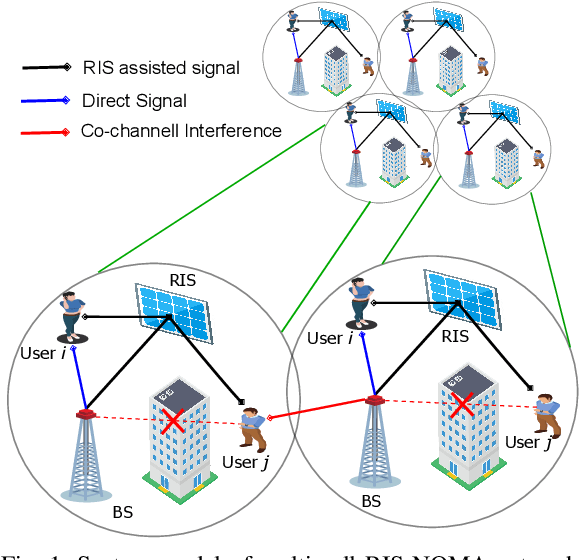
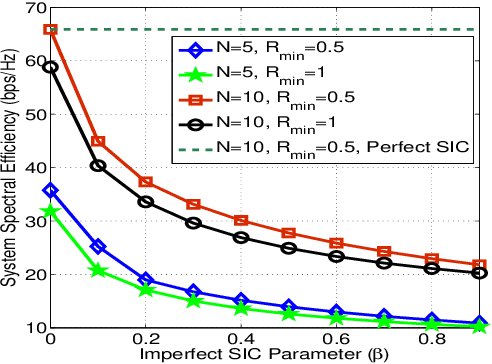
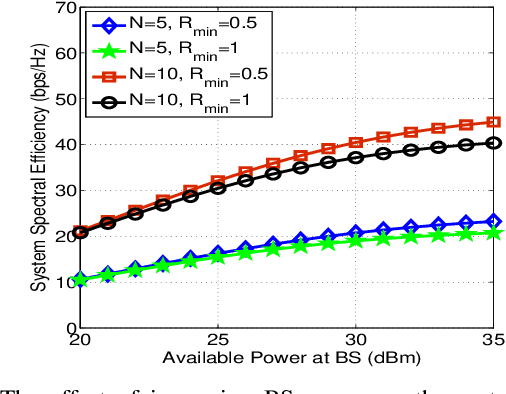
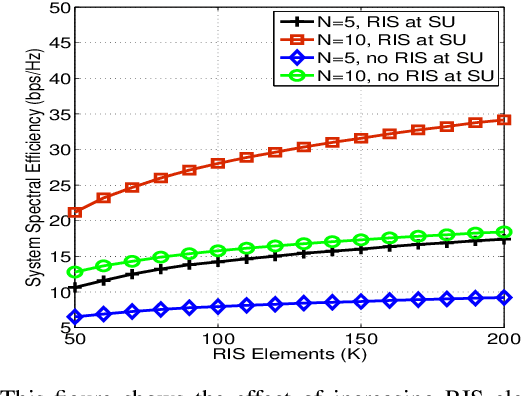
Abstract:Reflecting intelligent surfaces (RIS) has recently emerged as one of the promising technologies for achieving high energy and spectral efficiency in next-generation wireless networks. By using low-cost passive reflecting elements, RIS can smartly reconfigure the signal propagation to extend the wireless communication coverage. On the other side, Non-orthogonal multiple access (NOMA) has been proved as a key air interface technique for supporting massive connections over limited resources. This letter proposes a new optimization framework for the multicell RIS-NOMA network. In particular, we address the system spectral efficiency maximization with successive interference cancellation (SIC) decoding errors. The closed-form expressions of transmit power at the base station and power allocation coefficients of users are derived using Karush-Kuhn-Tucker conditions. Moreover, an efficient reflection matrix for RIS in each cell is designed using successive convex approximation and DC programming. Simulation results are provided to demonstrate the benefits of the proposed optimization in the multi-cell RISNOMA network.
Opportunities for Physical Layer Security in UAV Communication Enhanced with Intelligent Reflective Surfaces
Mar 31, 2022



Abstract:Unmanned Aerial Vehicles (UAVs) are an important component of next-generation wireless networks that can assist in high data rate communications and provide enhanced coverage.Their high mobility and aerial nature offer deployment flexibility and low-cost infrastructure support to existing cellular networks and provide many applications that rely on mobile wireless communications. However, security is a major challenge in UAV communications, and Physical Layer Security (PLS) is an important technique to improve the reliability and security of data shared with the assistance of UAVs. Recently, Intelligent Reflecting Surfaces (IRS) have emerged as a novel technology to extend and/or enhance wireless coverage by re-configuring the propagation environment of communications. This paper provides an overview of how IRS can improve the PLS of UAV networks. We discuss different use cases of PLS for IRS enhanced UAV communications and briefly review the recent advances in this area. Then based on the recent advances, we also present a case study that utilizes alternate optimization to maximize the secrecy capacity for IRS enhanced UAV scenario in the presence of multiple eavesdroppers. Finally, we highlight several open issues and research challenges to realize PLS in IRS enhanced UAV communications.
NOMA-enabled Backscatter Communications for Green Transportation in Automotive-Industry 5.0
Mar 10, 2022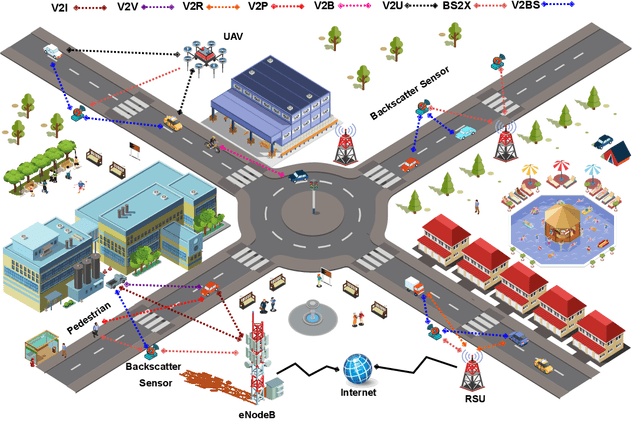
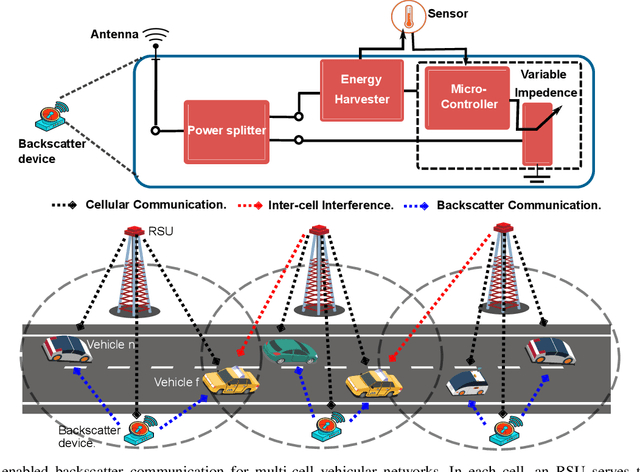
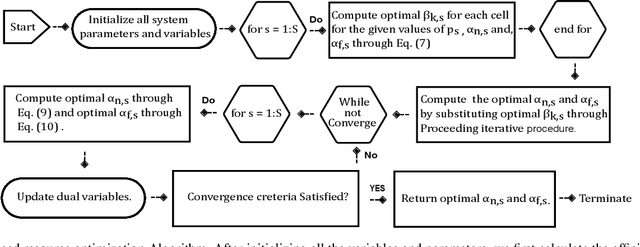
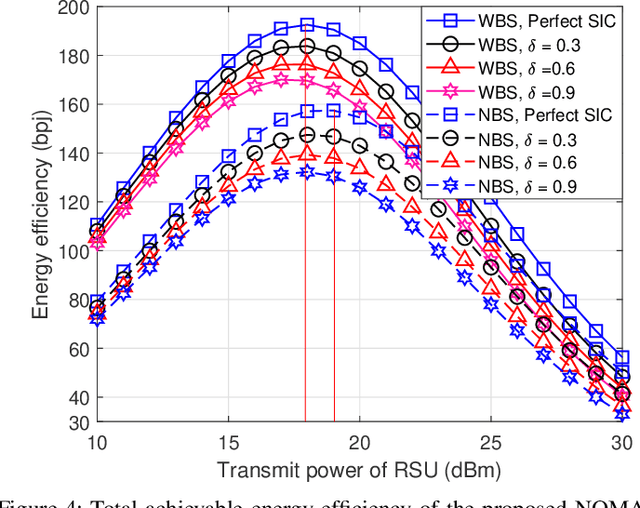
Abstract:Automotive-Industry 5.0 will use emerging 6G communications to provide robust, computationally intelligent, and energy-efficient data sharing among various onboard sensors, vehicles, and other Intelligent Transportation System (ITS) entities. Non-Orthogonal Multiple Access (NOMA) and backscatter communications are two key techniques of 6G communications for enhanced spectrum and energy efficiency. In this paper, we provide an introduction to green transportation and also discuss the advantages of using backscatter communications and NOMA in Automotive Industry 5.0. We also briefly review the recent work in the area of NOMA empowered backscatter communications. We discuss different use cases of backscatter communications in NOMA-enabled 6G vehicular networks. We also propose a multi-cell optimization framework to maximize the energy efficiency of the backscatter-enabled NOMA vehicular network. In particular, we jointly optimize the transmit power of the roadside unit and the reflection coefficient of the backscatter device in each cell, where several practical constraints are also taken into account. The problem of energy efficiency is formulated as nonconvex which is hard to solve directly. Thus, first, we adopt the Dinkelbach method to transform the objective function into a subtractive one, then we decouple the problem into two subproblems. Second, we employ dual theory and KKT conditions to obtain efficient solutions. Finally, we highlight some open issues and future research opportunities related to NOMA-enabled backscatter communications in 6G vehicular networks.
 Add to Chrome
Add to Chrome Add to Firefox
Add to Firefox Add to Edge
Add to Edge